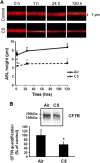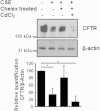Accumulation of metals in GOLD4 COPD lungs is associated with decreased CFTR levels
- PMID: 24957904
- PMCID: PMC4106203
- DOI: 10.1186/1465-9921-15-69
Accumulation of metals in GOLD4 COPD lungs is associated with decreased CFTR levels
Abstract
Background: The Cystic Fibrosis Transmembrane conductance Regulator (CFTR) is a chloride channel that primarily resides in airway epithelial cells. Decreased CFTR expression and/or function lead to impaired airway surface liquid (ASL) volume homeostasis, resulting in accumulation of mucus, reduced clearance of bacteria, and chronic infection and inflammation.
Methods: Expression of CFTR and the cigarette smoke metal content were assessed in lung samples of controls and COPD patients with established GOLD stage 4. CFTR protein and mRNA were quantified by immunohistochemistry and quantitative RT-PCR, respectively. Metals present in lung samples were quantified by ICP-AES. The effect of cigarette smoke on down-regulation of CFTR expression and function was assessed using primary human airway epithelial cells. The role of leading metal(s) found in lung samples of GOLD 4 COPD patients involved in the alteration of CFTR was confirmed by exposing human bronchial epithelial cells 16HBE14o- to metal-depleted cigarette smoke extracts.
Results: We found that CFTR expression is reduced in the lungs of GOLD 4 COPD patients, especially in bronchial epithelial cells. Assessment of metals present in lung samples revealed that cadmium and manganese were significantly higher in GOLD 4 COPD patients when compared to control smokers (GOLD 0). Primary human airway epithelial cells exposed to cigarette smoke resulted in decreased expression of CFTR protein and reduced airway surface liquid height. 16HBE14o-cells exposed to cigarette smoke also exhibited reduced levels of CFTR protein and mRNA. Removal and/or addition of metals to cigarette smoke extracts before exposure established their role in decrease of CFTR in airway epithelial cells.
Conclusions: CFTR expression is reduced in the lungs of patients with severe COPD. This effect is associated with the accumulation of cadmium and manganese suggesting a role for these metals in the pathogenesis of COPD.
Figures






Similar articles
-
Therapeutic strategies to reverse cigarette smoke-induced ion channel and mucociliary dysfunction in COPD airway epithelial cells.Am J Physiol Lung Cell Mol Physiol. 2025 Apr 1;328(4):L571-L585. doi: 10.1152/ajplung.00258.2024. Epub 2025 Mar 17. Am J Physiol Lung Cell Mol Physiol. 2025. PMID: 40095970 Free PMC article.
-
Augmentation of S-Nitrosoglutathione Controls Cigarette Smoke-Induced Inflammatory-Oxidative Stress and Chronic Obstructive Pulmonary Disease-Emphysema Pathogenesis by Restoring Cystic Fibrosis Transmembrane Conductance Regulator Function.Antioxid Redox Signal. 2017 Sep 1;27(7):433-451. doi: 10.1089/ars.2016.6895. Epub 2017 Feb 7. Antioxid Redox Signal. 2017. PMID: 28006950 Free PMC article.
-
Comparison of a novel potentiator of CFTR channel activity to ivacaftor in ameliorating mucostasis caused by cigarette smoke in primary human bronchial airway epithelial cells.Respir Res. 2024 Jul 10;25(1):269. doi: 10.1186/s12931-024-02889-w. Respir Res. 2024. PMID: 38982492 Free PMC article.
-
Cystic fibrosis transmembrane conductance regulator in COPD: a role in respiratory epithelium and beyond.Eur Respir J. 2023 Apr 1;61(4):2201307. doi: 10.1183/13993003.01307-2022. Print 2023 Apr. Eur Respir J. 2023. PMID: 37003609 Free PMC article. Review.
-
Cigarette smoke and CFTR: implications in the pathogenesis of COPD.Am J Physiol Lung Cell Mol Physiol. 2013 Oct 15;305(8):L530-41. doi: 10.1152/ajplung.00039.2013. Epub 2013 Aug 9. Am J Physiol Lung Cell Mol Physiol. 2013. PMID: 23934925 Free PMC article. Review.
Cited by
-
Fibrinogen mediates cadmium-induced macrophage activation and serves as a predictor of cadmium exposure in chronic obstructive pulmonary disease.Am J Physiol Lung Cell Mol Physiol. 2022 Apr 1;322(4):L593-L606. doi: 10.1152/ajplung.00475.2021. Epub 2022 Feb 24. Am J Physiol Lung Cell Mol Physiol. 2022. PMID: 35200041 Free PMC article.
-
N-acetyl cysteine reverts the proinflammatory state induced by cigarette smoke extract in lung Calu-3 cells.Redox Biol. 2018 Jun;16:294-302. doi: 10.1016/j.redox.2018.03.006. Epub 2018 Mar 14. Redox Biol. 2018. PMID: 29573703 Free PMC article.
-
Inferred inactivation of the Cftr gene in the duodena of mice exposed to hexavalent chromium (Cr(VI)) in drinking water supports its tumor-suppressor status and implies its potential role in Cr(VI)-induced carcinogenesis of the small intestines.Toxicol Appl Pharmacol. 2021 Dec 15;433:115773. doi: 10.1016/j.taap.2021.115773. Epub 2021 Oct 22. Toxicol Appl Pharmacol. 2021. PMID: 34688701 Free PMC article.
-
An Adverse Outcome Pathway for Decreased Lung Function Focusing on Mechanisms of Impaired Mucociliary Clearance Following Inhalation Exposure.Front Toxicol. 2021 Dec 14;3:750254. doi: 10.3389/ftox.2021.750254. eCollection 2021. Front Toxicol. 2021. PMID: 35295103 Free PMC article.
-
Dysfunction in the Cystic Fibrosis Transmembrane Regulator in Chronic Obstructive Pulmonary Disease as a Potential Target for Personalised Medicine.Biomedicines. 2021 Oct 10;9(10):1437. doi: 10.3390/biomedicines9101437. Biomedicines. 2021. PMID: 34680554 Free PMC article. Review.
References
-
- Chung KF, Adcock IM. Multifaceted mechanisms in COPD: inflammation, immunity, and tissue repair and destruction. Eur Respir J. 2008;31:1334–1356. - PubMed
-
- Sandford AJ, Weir TD, Pare PD. Genetic risk factors for chronic obstructive pulmonary disease. Eur Respir J. 1997;10:1380–1391. - PubMed
-
- Roth M. Pathogenesis of COPD: Part III. Inflammation in COPD. Int J Tuberc Lung Dis. 2008;12:375–380. - PubMed
-
- Boucher RC. New concepts of the pathogenesis of cystic fibrosis lung disease. Eur Respir J. 2004;23:146–158. - PubMed
-
- Cantin AM, Hanrahan JW, Bilodeau G, Ellis L, Dupuis A, Liao J, Zielenski J, Durie P. Cystic fibrosis transmembrane conductance regulator function is suppressed in cigarette smokers. Am J Respir Crit Care Med. 2006;173:1139–1144. - PubMed
Publication types
MeSH terms
Substances
Grants and funding
LinkOut - more resources
Full Text Sources
Other Literature Sources
Medical

